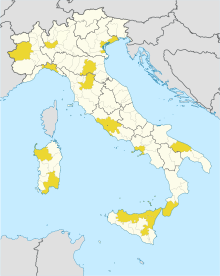Metropolitan cities of Italy

The metropolitan city (città metropolitana in Italian) is an administrative division of Italy, operative since 2015. The metropolitan city, as defined by law, includes a large core city and the smaller surrounding towns that are closely related to it with regard to economic activities and essential public services, as well as to cultural relations and to territorial features.
History
The original 1990 law individuated as metropolitan cities the comuni of Turin, Milan, Venice, Genoa, Bologna, Florence, Rome, Bari, Naples and their respective hinterlands, reserving the autonomous regions the right to individuate metropolitan areas in their territory.[1] In 2009, amendments added Reggio Calabria to the list.[2] The metropolitan areas individuated by the autonomous regions were: Trieste in Friuli-Venezia Giulia; Cagliari in Sardinia; Catania, Messina and Palermo in Sicily.
On 3 April 2014 the Italian Parliament approved a law that establishes 10 metropolitan cities in Italy,[3] excluding the autonomous regions. The new metropolitan cities have been operative since 1 January 2015.
Organisation
The metropolitan city is composed by the municipalities (comuni) that before had been members of the same province. Each metropolitan city is headed by a metropolitan mayor (sindaco metropolitano) assisted by a legislative body, the Metropolitan council (consiglio metropolitano), and by a non-legislative assembly, the metropolitan conference (conferenza metropolitana). Members of the Metropolitan council are elected and chosen by mayors and city councilors of each municipality in the metropolitan city, the metropolitan mayor is the mayor of the provincial capital. The metropolitan conference is composed by the mayors of the municipalities closest to the capital.[4]
The main functions devolved to the new metropolitan cities are:
- local planning and zoning;
- provision of local police services;
- transport and city services regulation.
Metropolitan cities
| Metropolitan city | Area (km²) | Population | Population Density (/km²) | Established | Mayor | |
|---|---|---|---|---|---|---|
| File:Città metropolitana di Roma Capitale - Stemma.png | Rome Roma |
5,352 | 4,336,915 | 810 | 3 April 2014 | Virginia Raggi (M5S) |
| Milan Milano |
1,575 | 3,190,340 | 2,026 | 3 April 2014 | Giuseppe Sala (PD) | |
| Naples Napoli |
1,171 | 3,128,702 | 2,672 | 3 April 2014 | Luigi De Magistris (MA) | |
| Turin Torino |
6,829 | 2,293,340 | 336 | 3 April 2014 | Chiara Appendino (M5S) | |
| File:Palermo-Stemma.png | Palermo Palermo |
5,009 | 1,276,525 | 255 | 4 August 2015 | Leoluca Orlando (I) |
| Bari Bari |
3,821 | 1,251,004 | 327 | 3 April 2014 | Antonio Decaro (PD) | |
| Catania Catania |
3,574 | 1,116,168 | 312 | 4 August 2015 | Enzo Bianco (PD) | |
| Florence Firenze |
3,514 | 1,007,435 | 287 | 3 April 2014 | Dario Nardella (PD) | |
| File:Bologna-Stemma.png | Bologna Bologna |
3,702 | 1,005,831 | 271 | 3 April 2014 | Virginio Merola (PD) |
| Genoa Genova |
1,839 | 864,008 | 470 | 3 April 2014 | Marco Doria (SI) | |
| Venice Venezia |
2,462 | 858,455 | 349 | 3 April 2014 | Luigi Brugnaro (I) | |
| File:Messina-Stemma.png | Messina Messina |
3,266 | 647,477 | 198 | 4 August 2015 | Renato Accorinti (I) |
| File:Reggio Calabria Stemma.png | Reggio Calabria Reggio Calabria |
3,183 | 558,959 | 176 | 3 April 2014 | Giuseppe Falcomatà (PD) |
| Cagliari Cagliari |
1,248 | 431,302 | 346 | 4 February 2016 | Massimo Zedda (SI) | |
See also
References
- ^ http://www.edscuola.it/archivio/norme/leggi/l142_90.html Law 8 June 1990 n. 142
- ^ Law 5 May 2009 n. 42
- ^ http://www.ilsole24ore.com/art/notizie/2014-04-03/addio-vecchie-provice-e-legge-ddl-delrio-144336.shtml?uuid=ABRoQ37
- ^ http://www.ilsole24ore.com/art/notizie/2014-04-03/citta-metropolitanei-nuovi-organi-203019.shtml?uuid=ABwmpA8&nmll=2707#navigation
External links
![]() Media related to Metropolitan cities of Italy at Wikimedia Commons
Media related to Metropolitan cities of Italy at Wikimedia Commons
